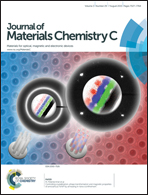Synthesis of planar dibenzo[de,op]bistetracene derivatives for organic field-effect transistor applications: substituent effect on crystal packing and charge transport property†
Abstract
A series of substituted dibenzo[de,op]bistetracenes (DBBTs) is prepared in short steps and their applications to organic field-effect transistors (OFETs) are described. These DBBT derivatives bear one or two methyl-, tert-butyl-, or fluoro groups at the 2-, 10-positions. X-ray diffraction studies reveal that the molecular structures of these DBBTs were planar with a shifted π–π stacking or herringbone-stacked type packing in the crystalline state. These substituents perturb the degree of stacking shift because of the steric effect and dipolar interaction, consequently affecting the electronic coupling between the neighboring molecules. Needle-like single crystals of DBBT derivatives were prepared by the vapor phase transfer method and used for the fabrication of single-crystal field-effect transistors (SCFETs). Theoretical calculation on these DBBTs has been performed to correlate the measured field-effect mobility with their molecular packing. The SCFET of di-methyl derivative 4b showed the highest hole mobility (1.19 cm2 V−1 s−1) with a current on/off ratio of 106.
![Graphical abstract: Synthesis of planar dibenzo[de,op]bistetracene derivatives for organic field-effect transistor applications: substituent effect on crystal packing and charge transport property](/en/Image/Get?imageInfo.ImageType=GA&imageInfo.ImageIdentifier.ManuscriptID=C5TC01455G&imageInfo.ImageIdentifier.Year=2015)

 Please wait while we load your content...
Please wait while we load your content...